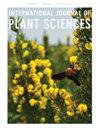Fruits of Anacardiaceae from the Paleogene of the Paris Basin, France
IF 1.5
3区 生物学
Q3 PLANT SCIENCES
引用次数: 1
Abstract
Premise of research. The Anacardiaceae family is distributed throughout the vegetated continents. The fossil record indicates extensive diversification of the family during the Paleogene and, in particular, during the Eocene. Despite the abundant fossil record of this period, there are only a few reliable anacardiaceous fossils in the Paris Basin. Here, we aim to document newly recognized fossils of Anacardiaceae from the Paris Basin, understand their paleoecology, and discuss their biogeographic history. Methodology. Thirty-three lignite fruits were examined from two sites, one before and one after the Paleocene-Eocene boundary (i.e., Petit Pâtis [Rivecourt] and Le Quesnoy [Houdancourt]). The specimens were photographed, and anatomy was studied using computed tomography and histological sections. Comparative analyses were undertaken using available descriptions of fossil and modern fruits of Anacardiaceae. Pivotal results. A new species, Cyrtocarpa biapertura sp. nov., is described on the basis of a unilocular fruit with two prominent apertures present on the ventral side of the endocarp, protruding into two lacunae surrounding the locule. Taphonomic analysis indicates that this plant grew close to riverbanks. Furthermore, a new record of “Lannea” europaea (Reid and Chandler) Chandler is reported for the Eocene site. Conclusions. The occurrence of Cyrtocarpa in both the Paleocene and the Eocene floras in the Paris Basin suggests similar vegetation during both time intervals. It is likely that both floras grew under similar subtropical climates. Moreover, it appears that the early Eocene shows an enrichment of the paleodiversity of Anacardiaceae and other plant families in the Paris Basin. The presence of Cyrtocarpa documents a rarely reported disjunction between the Paleogene of Europe and the recent tropical flora of South America.来自法国巴黎盆地古近纪的水仙桃科的果实
研究的前提。红心科分布在整个植被覆盖的大陆。化石记录表明,在古近纪,特别是始新世,该家族广泛多样化。尽管这一时期的化石记录丰富,但巴黎盆地可靠的无心质化石却很少。在此,我们旨在记录巴黎盆地新发现的阿纳卡达科化石,了解它们的古生态,并讨论它们的生物地理历史。方法。在古新世-始新世界线之前和之后的两个地点(即Petit p [Rivecourt]和Le Quesnoy [Houdancourt])对33个褐煤果实进行了检查。对标本进行拍照,并使用计算机断层扫描和组织学切片进行解剖研究。比较分析进行了利用现有的描述化石和现代水果的红心科。关键的结果。一个新种,Cyrtocarpa biapertura sp. nov.,描述了一个单室的果实,在果皮的腹侧有两个突出的孔,突出到两个腔室周围。地理分析表明这种植物生长在靠近河岸的地方。此外,还报道了始新世遗址“Lannea”europaea (Reid and Chandler) Chandler的新记录。结论。在巴黎盆地古新世和始新世植物区系中都有Cyrtocarpa的出现,这表明在这两个时间间隔内的植被相似。很可能这两种植物都生长在相似的亚热带气候下。此外,早始新世在巴黎盆地表现出了阿纳卡迪科和其他植物科的丰富的古多样性。Cyrtocarpa的存在证明了欧洲古近纪与南美洲近代热带植物群之间很少有报道的分离。
本文章由计算机程序翻译,如有差异,请以英文原文为准。
求助全文
约1分钟内获得全文
求助全文
来源期刊
CiteScore
4.50
自引率
4.30%
发文量
65
审稿时长
6-12 weeks
期刊介绍:
The International Journal of Plant Sciences has a distinguished history of publishing research in the plant sciences since 1875. IJPS presents high quality, original, peer-reviewed research from laboratories around the world in all areas of the plant sciences. Topics covered range from genetics and genomics, developmental and cell biology, biochemistry and physiology, to morphology and anatomy, systematics, evolution, paleobotany, plant-microbe interactions, and ecology. IJPS does NOT publish papers on agriculture or crop improvement. In addition to full-length research papers, IJPS publishes review articles, including the open access Coulter Reviews, rapid communications, and perspectives. IJPS welcomes contributions that present evaluations and new perspectives on areas of current interest in plant biology. IJPS publishes nine issues per year and regularly features special issues on topics of particular interest, including new and exciting research originally presented at major botanical conferences.

 求助内容:
求助内容: 应助结果提醒方式:
应助结果提醒方式:


